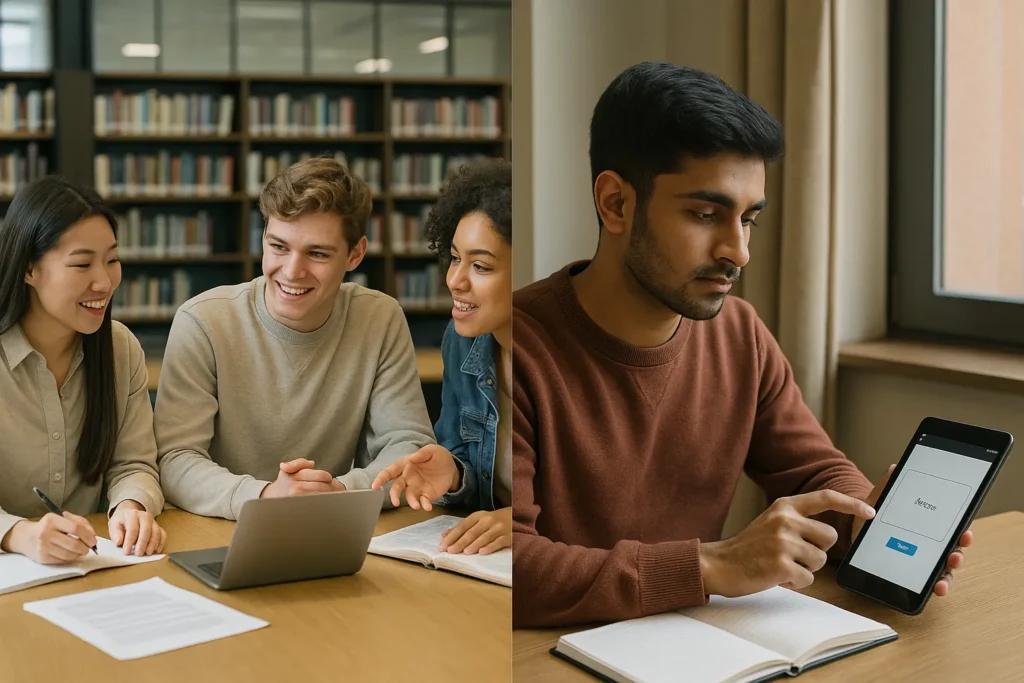How do you know if your late-night solo grind is helping, or if you’d get more out of studying with others? For some, silence makes things clearer. However, for others, it turns into mind-wandering and half-finished notes.
In this article, we’ll break down group study benefits and solo study techniques, share real-world tips, and help you find the best study method for you to learn usefully. You’ll also get a few tools and a quick self-check to decide on your preferred study method.
Skip the trial and error. Use this guide to study smarter and get results that reflect your effort. Read on to learn more.
Group Study Benefits That Improve Learning
Studying with others can make a massive difference to how well you focus, retain ideas, and stay consistent. When the group is well-organised, it becomes easier to stick with the material and cover more ground with less frustration.

Why Group Learning Helps You Stay Engaged
Studying in a group adds structure, variety, and a bit of healthy pressure. It keeps the pace lively and introduces different ways of thinking that sharpen your understanding. Researchers found that 60% of students consider group study to be helpful for their effective learning.
When done right, it makes the process feel more active and less intimidating. Here’s what causes group study to be so useful:
- Peer motivation: Your well-prepared classmates constantly motivate you to improve your game.It creates a natural sense of accountability and keeps you on schedule when your own focus starts to fade.
- New perspectives: Other students often explain things in a way that suddenly makes sense. Hearing how someone else connects the dots can reveal shortcuts, tools, or real-world links you hadn’t thought of.
- Active discussion: Speaking up helps you process material faster. Talking through ideas out loud forces you to understand them clearly enough to explain, and that’s when real learning happens.
Common Group Study Errors and Working Solutions
Even motivated groups can fall into bad habits. Without structure, sessions lose track and energy burns out. A few simple adjustments can keep things running smoothly and make your time together more productive.
Watch for these common slip-ups and try these fixes:
- No clear goal: Sessions without direction usually lead nowhere. Set a short agenda before starting. Break the time into focus areas so no topic drags on or gets skipped.
- Too many voices: When everyone talks at once, progress slows. Assign roles. Have one person guide the discussion, another take notes, and someone manage the time.
- Scattered notes and tools: When resources are all over the place, it’s hard to stay aligned. Use shared platforms like Google Docs or Padlet to store questions, links, and notes in one easy-access space.
A focused group brings fresh energy to your study routine. With the right setup, you stay on task, cover more material, and walk away feeling clear.
Solo Study Techniques That Always Work
Some tasks need silence, full focus, and your own pace. Solo study gives you that space. It helps you go deeper into tricky topics, avoid distractions, and stay in control of your schedule.

When the goal is clarity and calm, studying alone frequently gets you there faster.
Proven Solo Study Methods That Build Focus
Having a few techniques in place makes solo study smoother and more effective. Without arrangement, sessions can drag or lead to burnout.
These methods help you work smarter and keep your mind fresh.
Pomodoro Method to Improve Study Sessions
Studying in short bursts helps prevent mental fatigue. The Pomodoro technique uses 25-minute focus blocks with short breaks in between. This keeps energy levels steady and helps you get through longer tasks without losing momentum.
Feynman Technique to Deepen Understanding
Explaining a concept in plain language helps you check your understanding of it. The Feynman technique involves teaching the topic out loud, detecting weak points, and then going back to review. It’s an active way to learn, which keeps your brain engaged.
Spaced Repetition to Boost Long-Term Memory
Instead of stuffing everything, use tools like Anki or Quizlet to space out your reviews. These apps prompt you to revisit material just before you forget it, which strengthens recall and builds lasting memory. They are perfect for definitions, formulas, and complex facts.
How to Stay Motivated When Studying Alone
Solo study needs momentum. Small habits like creating a dedicated space, using checklists, tracking your progress visually, and building in rewards after each task help massively.
Based on our experience, students who follow these techniques stay more focused, retain more, and finish their work with less stress.
How to Choose the Best Study Method for Each Situation
Solo and group study both have their place, but the real benefit comes when you match your approach to the task. Some tasks need quiet repetition, while others call for discussion, feedback, or peer interaction.
Picking the right approach helps you stay focused and make real progress.
Study Method by Exam Type and Subject
Subjects vary in how they challenge your brain. Some subjects push for discussion and interpretation. However, specific other subjects may call for full focus and repetition. Matching the method helps you learn more efficiently and save time.
The examples below can help you choose what fits best for each type.
- Theory-based subjects (e.g. History, Literature): Group study works well here. Sharing ideas helps understand complex arguments, spot weak reasoning, and boost essay preparation. For example, analysing a novel like To Kill a Mockingbird becomes better when others highlight themes or perspectives you hadn’t considered.
- Detail-heavy subjects (e.g. Maths, Chemistry): Solo study allows time to practise formulas, redraw diagrams, and repeat problem-solving steps without distractions. A good example is revising reaction pathways in organic chemistry, where repetition builds accuracy and confidence.
- Creative tasks (e.g. Design, Music, Essays): Start alone to sketch ideas, plan your outline, or compose a draft. Then, meet with peers to gather feedback and improve flow, clarity, or structure. For instance, a music student might first compose a melody solo, then refine it after performing it for classmates.
- Oral exams and presentations: Begin solo with scripting and timing practice. Once you’ve got the basics down, rehearse with friends to get feedback on tone, clarity, and body language. Such as, practising a mock presentation with a classmate helps prepare for pressure and unexpected questions.
Flex Study: Switch Approaches to Stay Productive
You don’t need to pick just one method. Adjust based on the subject, the type of assessment, or how much time you have. Use solo study to lay the groundwork, then revisit complex areas with a study partner or group.
This flexible mix oftentimes leads to better focus, stronger retention, and less time wasted. It also helps you stay motivated without getting stuck.
Real Stories From Students: What Works?
These stories show how simple changes in routine can lead to better focus, improved confidence, and stronger results. One study method might suit your learning style more than another, and finding that fitting method can change everything.

Peer Group Study That Helped a Science Student Excel
Mia was falling behind in science. She understood the basics but couldn’t connect them well in assignments or discussions. She joined a study group with three classmates and met twice a week over video.
Each person prepped notes or quizzes, and they took turns explaining a topic. Hearing the material explained in different ways helped her understand it faster. Teaching small parts also increased her confidence.
By the end of term, her project received top marks, and she became more active in class conversations.
Spaced Repetition as a Solo Study Technique for Maths
Dev preferred silence when working through difficult topics. He used Anki to build a custom deck of maths flashcards, including formulas and worked examples. With spaced repetition, the system showed each card at the right time, just before forgetting would normally set in.
This routine helped him strengthen tricky concepts without squeezing everything. After a few weeks, his test accuracy improved, and he felt calm heading into assessments knowing he had trained consistently.
Why Testing Methods Helps You Improve Faster
Everyone learns in different ways. Some need structure, others prefer flexibility. Trying out new methods, like Mia and Dev did, leads you to notice what clicks.
When you build your routine around the things that help you retain and apply information, study time becomes more effective and less stressful.
What Research Says About Effective Study Techniques
Study routines help set the pace, but the way your brain handles information determines lasting results.
Research in cognitive psychology and neuroscience points to a few strategies that consistently support better memory, focus, and understanding. These insights show what works behind the scenes when you revise.
Study Smarter With Proven Brain-Based Tips
The research below displays practical ways to align your study methods with how the brain learns. Each finding comes from reputable studies and offers a useful change in approach.
- Collaborative learning sharpens critical thinking: A study in the Journal of Technology Education found that students working in small groups developed stronger reasoning by explaining and challenging ideas. Conversations reveal gaps, clarify confusion, and deepen understanding.
- Spaced repetition improves retention: A review in Educational Psychology Review confirms that spacing out review sessions helps store information in long-term memory. Tools like Anki and Quizlet apply this model with precision.
- Lowering cognitive load supports recall: According to Sweller’s research (1988), dividing material into smaller chunks improves focus and comprehension. Contrarily, trying to absorb too much at once reduces what you remember.
- Peer teaching increases retention: A 2014 study found that students who taught material to others retained more and performed better in tests. This shows why explaining ideas during group study is so effective.
When your methods reflect your preferred learning style, your effort repays with better results and less wasted time.
Quick Quiz to Find Your Best Study Method
Study habits work best when they match how you think, focus, and recall. This quiz gives a quick picture of which approach fits you best.

For each question, answer YES = 1 point and NO = 0 points. Add up your total at the end to see your study match.
- When you’re confused about a topic, do you prefer talking it through with someone rather than figuring it out alone?
- Do you get distracted or lose focus when others are talking or moving around you?
- Do you find that explaining concepts to others helps you understand them better yourself?
- Do you prefer to master material completely on your own before discussing it with anyone?
- When preparing for exams, do you feel more confident after group review sessions?
- Do you work most efficiently when you can control your environment (lighting, noise, timing)?
- Do you enjoy brainstorming solutions with classmates more than working through problems independently?
- Do you find other people’s study methods or pace interfere with your own learning process?
- When you’re stuck on a problem, is your first instinct to ask someone for help or hints?
- Do you prefer creating your own study schedule without having to coordinate with others?
- Do you learn better when you can hear multiple perspectives and approaches to the same topic?
- Do you feel more accountable and motivated when you have to report progress to yourself rather than others?
What Your Quiz Score Suggests
0-3 points: Strong solo study preference. You work best in calm, self-paced environments with minimal distractions. You process information deeply when alone and prefer complete control over your learning environment. Stick with tools like Pomodoro, spaced repetition, and structured routines.
4-5 points: Slight solo study lean. You’re more focused alone but may still benefit from occasional group review or check-ins to clear doubts and get perspective. Consider solo study for learning new material, then brief group sessions for clarification.
6-7 points: Mixed approach works best. You benefit from both independent focus time and collaborative energy. Use solo study to absorb and practice, then meet with others to review, quiz, or talk through key topics. Switch between methods based on the material and your energy levels.
8-9 points: Slight group study lean. You benefit from talking things out and external motivation, but also need some quiet processing time. Group study works well when paired with short solo sessions for reflection and consolidation.
10-12 points: Strong group study preference. You focus better with discussion, feedback, and shared energy. You learn through verbal processing and benefit from multiple perspectives. Weekly group sessions, study partnerships, or peer calls will help you stay engaged and on track.
Find the Best Study Method for Real Results
Study battles usually start with the method rather than the material. Some students may get distracted in groups, while others study better alone. If you’re not learning as efficiently as you’d like, there are practical tools and strategies that can help. With the right setup, you can study better and feel more in control.
This guide covered group study benefits, solo study techniques, and how to switch between them based on the subject. We shared research-backed tips, common mistakes, and simple tools like Pomodoro and spaced repetition. You also saw how real students used these strategies to build confidence and improve performance.
Visit ECCE 2012 and enrol in a course that matches how you learn best. Our tutors design every class to help you sharpen skills, build confidence, and move closer to your academic or career goals. Remember, results follow action. Start now!


